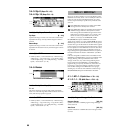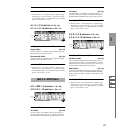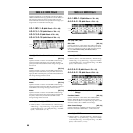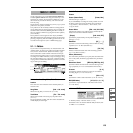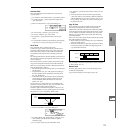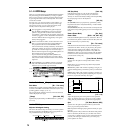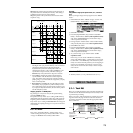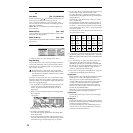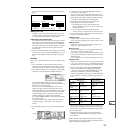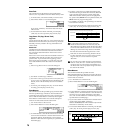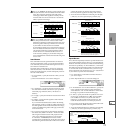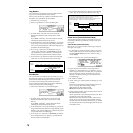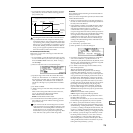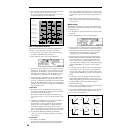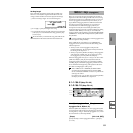
74
5.2–1a: Track Select, Measure (From)/Meas. (To End
of)
Track Select [T01...T16, Master Trk]
Use the cursor keys [ ][ ] to select the track in which you
wish to record or edit (or use as the copy source).
If you wish to select all tracks, you do not need to select
T01...T16. Simply check “All Tracks” in the dialog box of the
utility menu command.
Master Trk: You can edit the tempo and time signature of
the master track.
Measure (From) [001...999]
Specify the first measure that will be edited (or used as the
copy source) or step-recorded.
Meas. (To End of) [001...999]
Specify the last measure that will be edited (or used as the
copy source).
■ 5.2–1b: UTILITY
☞“Memory Status” (1.1–1d), “Rename Track” (5.1–1c)
Step Recording
Step recording allows you to specify the length and velocity
of each note numerically, and to input the pitches from the
keyboard. You can use the[F4] (“Rest”) key and [F5] (“Tie”)
key to input a rest or tie.
Be aware that if you step-record onto a track which
already contains sequence data, all data will be erased
from the measure specified in “Measure (From)” and all
subsequent measures.
It is best to use the “Create/Ers. Ctrl” Create mode to input
data whose data whose value changes continuously, such as
pitch bend, and to use “Event Edit” to input individual data
items such as program changes.
1 Use “Track Select” to select the track into which you wish
to input data, and use Track Edit tab item “Measure
(From)” to specify the measure at which you wish to
begin input.
2 When you select “Step Recording,” the following dialog
box will appear.
3 In “Meter,” set the time signature.
This will show the time signature that has already been
set for the measure.
If you change the time signature setting, the time signa-
ture data of the measures you record will change, and all
tracks will change to the time signature you specified.
4 In “Step (Step Time),” specify the length of the basic step
that you wish to input, in terms of a note value.
For “Step (Step Time),” a Triplet (3)/Normal(–)/Dot(.)
symbol located at the right of the note type indicates the
length of the note.
The note type can be selected from a range of
(whole
note) – (32nd note).
If you set Triplet/Normal/Dot to 3 (Triplet), triplets of
the specified note value will be used as the step time. If
you select “–” (Normal), the specified note value will be
used without change. If you select “.” (Dot), the specified
note will be dotted.
The following table shows the number of clocks for each
“Step (Step Time)” setting.
5 In “Duration,” specify the length that the note will actu-
ally be held, relative to the “Step (Step Time).” In general,
100% will be tenuto, 85% will be normal, and 50% will be
staccato.
6 Use “Vel (Velocity)” to specify the velocity value (key-
board playing strength) of the note data. With the
[PAUSE] key pressed, you can hold down the [ENTER]
key and play a note on the keyboard to specify the veloc-
ity value. If you set this to Key, the actual velocity at
which you played the key will be input.
7 Note events can be input as described below, using com-
mands from the keyboard and function keys.
Inputting notes
When you press a key on the keyboard, that note number
will be input as a note of the length specified in
4.
When you press a chord on the keyboard, those note
numbers will be input as chords of the length specified in
4. Since each of the note numbers you press before
releasing all of the keys will be input at the same loca-
tion, the notes will be input as a chord even if they are
actually played at different times.
Each time you press and release the keyboard, the loca-
tion will advance by the length specified in
4.
Inputting rests
Press the [F4] (“Rest”) key to input a rest of the length
specified in
4.
Inputting a tie
If you press the [F5] (“Tie”) key without pressing the key-
board, the previously-input note will be tied, and length-
ened by the amount specified in
4.
If you press the [F5] (“Tie”) key while holding down a
note, the note you are playing will be tied, and length-
ened by the amount specified in
4.
Note numberLocation within the
measure (beat, clock)
Length (beat, clock)
Time signature
Velocity
(0:24)
(0:48)
(0:96)
(1:00)
(2:00)
(4:00)
(0:36)
(0:72)
(0:144)
(1:96)
(3:00)
(6:00)
(0:16)
(0:32)
(0:64)
(0:128)
(1:64)
(2:128)
333333



